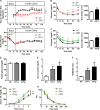Prostaglandin E2 receptor EP3 regulates both adipogenesis and lipolysis in mouse white adipose tissue
- PMID: 27436752
- PMCID: PMC5181317
- DOI: 10.1093/jmcb/mjw035
Prostaglandin E2 receptor EP3 regulates both adipogenesis and lipolysis in mouse white adipose tissue
Abstract
Among the four prostaglandin E2 receptors, EP3 receptor is the one most abundantly expressed in white adipose tissue (WAT). The mouse EP3 gene gives rise to three isoforms, namely EP3α, EP3β, and EP3γ, which differ only at their C-terminal tails. To date, functions of EP3 receptor and its isoforms in WAT remain incompletely characterized. In this study, we found that the expression of all EP3 isoforms were downregulated in WAT of both db/db and high-fat diet-induced obese mice. Genetic ablation of three EP3 receptor isoforms (EP3-/- mice) or EP3α and EP3γ isoforms with EP3β intact (EP3β mice) led to an obese phenotype with increased food intake, decreased motor activity, reduced insulin sensitivity, and elevated serum triglycerides. Since the differentiation of preadipocytes and mouse embryonic fibroblasts to adipocytes was markedly facilitated by either pharmacological blockade or genetic deletion/inhibition of EP3 receptor via the cAMP/PKA/PPARγ pathway, increased adipogenesis may contribute to obesity in EP3-/- and EP3β mice. Moreover, both EP3-/- and EP3β mice had increased lipolysis in WAT mainly due to the activated cAMP/PKA/hormone-sensitive lipase pathway. Taken together, our findings suggest that EP3 receptor and its α and γ isoforms are involved in both adipogenesis and lipolysis and influence food intake, serum lipid levels, and insulin sensitivity.
Keywords: EP3 receptor isoform; PKA; PPARγ; arachidonic acid; insulin resistance; obesity.
© The Author (2016). Published by Oxford University Press on behalf of Journal of Molecular Cell Biology, IBCB, SIBS, CAS. All rights reserved.
Figures






Similar articles
-
Importance of adipocyte cyclooxygenase-2 and prostaglandin E2-prostaglandin E receptor 3 signaling in the development of obesity-induced adipose tissue inflammation and insulin resistance.FASEB J. 2016 Jun;30(6):2282-97. doi: 10.1096/fj.201500127. Epub 2016 Mar 1. FASEB J. 2016. PMID: 26932930
-
Characterization of Motor Neuron Prostaglandin E2 EP3 Receptor Isoform in a Mouse Model of Amyotrophic Lateral Sclerosis.Biol Pharm Bull. 2015;38(12):1964-8. doi: 10.1248/bpb.b15-00418. Biol Pharm Bull. 2015. PMID: 26632188
-
Prostaglandin E2 Exerts Multiple Regulatory Actions on Human Obese Adipose Tissue Remodeling, Inflammation, Adaptive Thermogenesis and Lipolysis.PLoS One. 2016 Apr 28;11(4):e0153751. doi: 10.1371/journal.pone.0153751. eCollection 2016. PLoS One. 2016. PMID: 27124181 Free PMC article.
-
Lipid Storage, Lipolysis, and Lipotoxicity in Obesity.Adv Exp Med Biol. 2024;1460:97-129. doi: 10.1007/978-3-031-63657-8_4. Adv Exp Med Biol. 2024. PMID: 39287850 Review.
-
Omega-3 fatty acids and adipose tissue biology.Mol Aspects Med. 2018 Dec;64:147-160. doi: 10.1016/j.mam.2018.01.004. Epub 2018 Jan 17. Mol Aspects Med. 2018. PMID: 29329795 Review.
Cited by
-
Multidrug resistance-associated protein 4 (Mrp4) is a novel genetic factor in the pathogenesis of obesity and diabetes.FASEB J. 2021 Feb;35(2):e21304. doi: 10.1096/fj.202001299RR. FASEB J. 2021. PMID: 33417247 Free PMC article.
-
CILP-2 is a novel secreted protein and associated with insulin resistance.J Mol Cell Biol. 2019 Dec 19;11(12):1083-1094. doi: 10.1093/jmcb/mjz016. J Mol Cell Biol. 2019. PMID: 30896018 Free PMC article.
-
Emphasis on Adipocyte Transformation: Anti-Inflammatory Agents to Prevent the Development of Cancer-Associated Adipocytes.Cancers (Basel). 2023 Jan 13;15(2):502. doi: 10.3390/cancers15020502. Cancers (Basel). 2023. PMID: 36672449 Free PMC article. Review.
-
International Union of Basic and Clinical Pharmacology. CIX. Differences and Similarities between Human and Rodent Prostaglandin E2 Receptors (EP1-4) and Prostacyclin Receptor (IP): Specific Roles in Pathophysiologic Conditions.Pharmacol Rev. 2020 Oct;72(4):910-968. doi: 10.1124/pr.120.019331. Pharmacol Rev. 2020. PMID: 32962984 Free PMC article.
-
Application of a dye-based mitochondrion-thermometry to determine the receptor downstream of prostaglandin E2 involved in the regulation of hepatocyte metabolism.Sci Rep. 2018 Aug 30;8(1):13065. doi: 10.1038/s41598-018-31356-y. Sci Rep. 2018. PMID: 30166566 Free PMC article.
References
-
- Arner P., and Langin D. (2014). Lipolysis in lipid turnover, cancer cachexia, and obesity-induced insulin resistance. Trends Endocrinol. Metab. 25, 255–262. - PubMed
-
- Bastard J.P., Maachi M., Lagathu C., et al. . (2006). Recent advances in the relationship between obesity, inflammation, and insulin resistance. Eur. Cytokine Netw. 17, 4–12. - PubMed
-
- Borglum J.D., Pedersen S.B., Ailhaud G., et al. . (1999). Differential expression of prostaglandin receptor mRNAs during adipose cell differentiation. Prostaglandins Other Lipid Mediat. 57, 305–317. - PubMed
Publication types
MeSH terms
Substances
Grants and funding
LinkOut - more resources
Full Text Sources
Other Literature Sources
Miscellaneous

